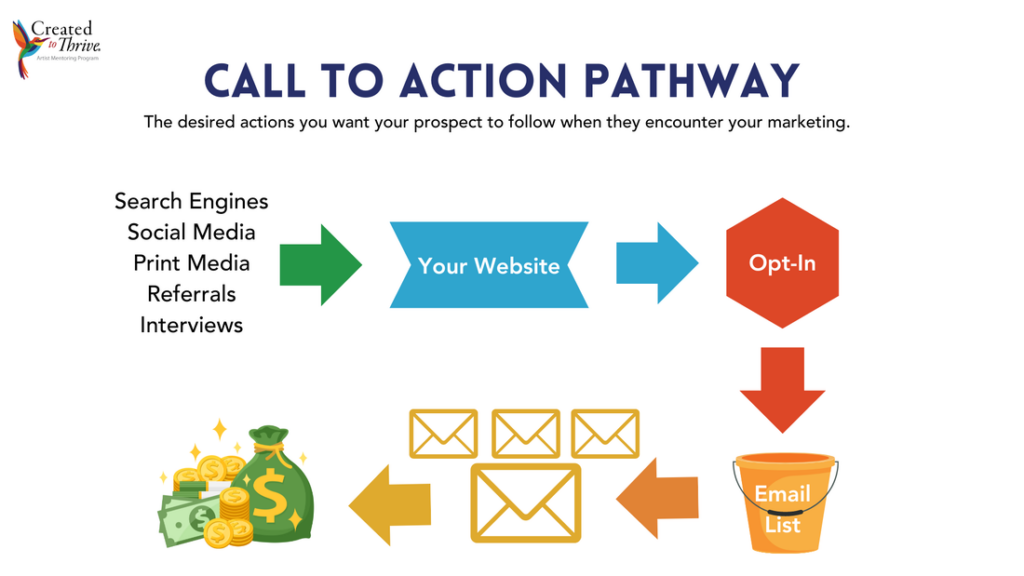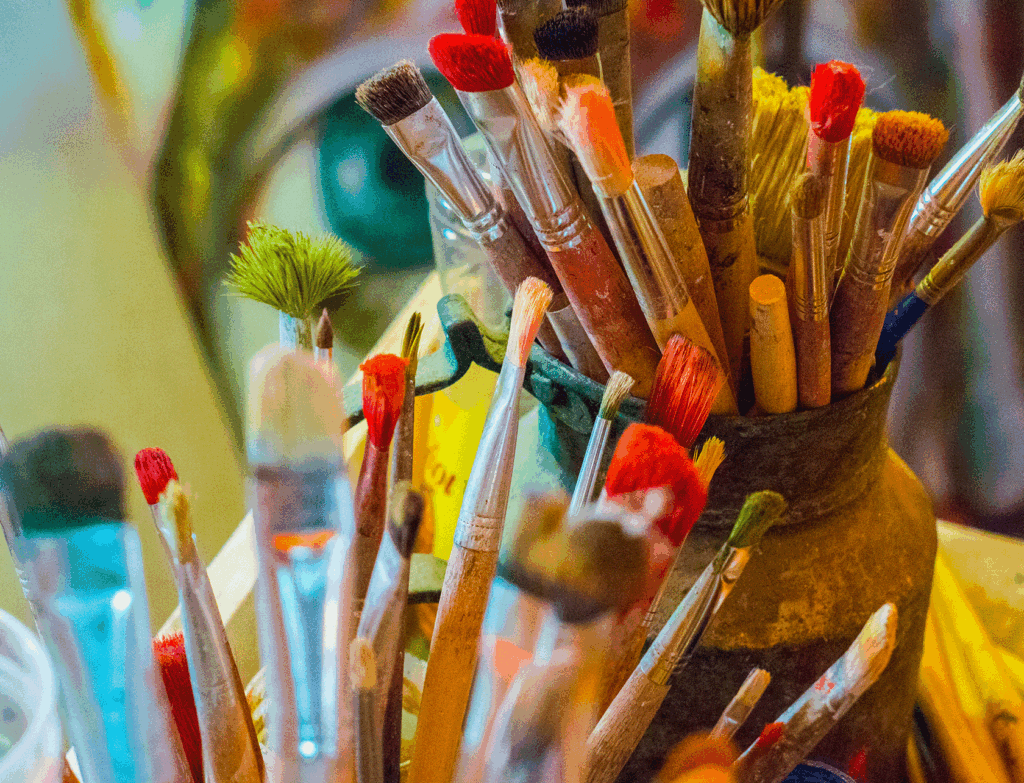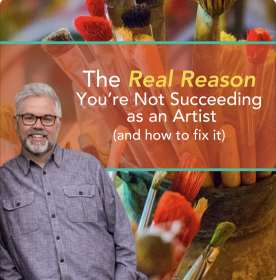
When it comes to art marketing, there can be a lot of confusion about what works, what doesn’t and where to start. Whether you’re a seasoned, experienced artist who’s been creating for many years or a hobbyist just trying to take it to the next level, knowing how to sell your art is of primo importance!
Art Marketing is about the “Special Factor”
I’ve had the privilege of creating sculpture both part-time and full-time for almost 25 years. After moving to Asheville, North Carolina in 2009, I opened a studio in the River Arts District and began selling my work full-time. Like a lot of artists, I did the typical things like running around to craft shows, selling wholesale to shops and “hoping” for customers. For me – and remember, everyone’s different – that kind of selling drove me crazy! Shows were fickle, my work didn’t sell great in stores or galleries because I wasn’t there to talk about it and the hope strategy… well, let’s just say that doesn’t work. Hope is not a viable strategy for how to sell your art.
Thankfully, because of my background in marketing and the fact that I am a people person, I recognized early on in my full-time art career that people pay top dollar for 2 things: special and connection. What does that mean, you ask?
First of all, people are willing to pay a premium for things they feel are out of the ordinary, unique or special, especially if they align with their values. Now keep in mind, we’re not talking about your average Wal-mart shopper here. I’m talking about people who are genuinely interested in your art and have the means to pay for it. When your work and your reputation is seen as something to be noticed, something to be valued, not ordinary or run-of-the-mill, all of a sudden, people start to take notice. That’s what happened to me. I create sculpture primarily for luxury mountain homes and I love it. One of the things I did to help leverage the “special factor” of my work was to make a decision to install all my own work (when possible) and ask if I could take pictures once installed. Consequently, I have tons of gorgeous images of my work in multi-million dollar homes. Now, when prospective buyers are considering my work, they immediately see “Wow, this guy’s work is special… look at who’s buying his work.” It lets my customers know that I’m someone to be collected and considered worthy of a significant investment.
Art Marketing is about Authentic Connection

The other huge concept I employ in my business naturally, because I enjoy building relationships with people, is connection. I’ve found over the years that people who are making a significant investment in a piece of art want more than just a commoditized retail experience. They want a relationship.
By and large, whether it’s buying my work or the work of friends of mine who are painters, sculptors, ceramicists, jewelers or whatever, clients who are serious about purchasing hand-made, original art really enjoy building relationships with the artists from whom they purchase. It’s fun for them and for us to get to know them, what they like, what they like about our work and deepen that relationship over time through multiple purchases and referrals to their friends.
I have a studio here in Asheville’s River Arts District which is open 6 days a week to the public. Nothing gives me more pleasure than to hear one of my clients coming through the door with a friend or out of town visitor saying something like “Oh, this is the guy I was telling you about…” All of a sudden, they’ve become my marketing department and a genuine friend.
This same kind of connection is very important even if you’re selling through strategic partners like interior designers or gallery / shop owners. Take time to go visit them, learn what sells in their stores, understand their clientele and then work to make them look great! I have a friend up who has a beautiful furniture store in a very wealthy area and she has a trunk show for me every couple of years. That one relationships has produced more than any other relationship in my art career simply because every time I go to that area, I stop by and say hello. I send flowers after a referral. I treat her customers very well. Yes, you guessed it: I’m building connection.
How Can I Recommend My Art to Potential Customers Instead of “Selling” It?
When it comes to recommending your art to potential customers, it can be helpful to shift your perspective away from traditional sales tactics and focus on the idea of sharing something you truly believe in. Instead of trying to sell your art, imagine that you are recommending it to a friend – someone you genuinely care about and want to enrich their lives with something you find meaningful.
Think about it this way: when you recommend a great restaurant or a captivating book to a friend, your motivation is not driven by financial gain but by the desire to share an amazing experience with someone you care about. You want them to enjoy and benefit from it just as much as you did.
The same principle applies to promoting your artwork. Instead of solely focusing on making a sale, put yourself in your potential customer’s shoes. Ask yourself why they might appreciate your art and how it could positively impact their lives. Consider what makes your art unique, what emotions it evokes, or what stories it tells. By understanding these aspects, you can genuinely recommend your artwork to others, positioning it as something that would bring value and enrichment to their lives.
When you approach potential customers with a genuine recommendation mindset, you create a more personal connection. Share the story behind your art, the inspiration that drove you to create it, and why it holds a special place in your heart. By communicating your passion and the value your art brings, you shift the focus from “selling” to connecting and sharing.
Remember, recommending your art allows you to authentically express why it could resonate with others, rather than coming across as pushy or sales-oriented. So, let your enthusiasm shine through and guide your interactions with potential customers. Showcase your artwork in a way that conveys the thought and care you’ve put into it, highlighting how it could enhance their lives and offer them a unique and meaningful experience.
When recommending your art to potential customers, focus on sharing something meaningful rather than solely aiming to make a sale. Approach it as if you are recommending it to a friend, emphasizing the value it could bring to their lives. By genuinely connecting with your potential customers and highlighting the unique aspects of your art, you can create a more personal and authentic experience for both them and you.
How Can I Write Persuasively to Persuade People to Buy My Art?
When it comes to persuading people to buy your art, persuasive writing plays a critical role. Marketing, at its core, revolves around the power of persuasion. In order to effectively connect with your audience and convince them to invest in your artwork, it is crucial to employ persuasive techniques.
To begin, don’t rely solely on presenting a list of facts or simply stating “buy this.” Instead, focus on crafting compelling narratives that evoke emotions and resonate with your potential buyers. Share the story behind your art, its inspiration, and the journey it took to create it. By offering a glimpse into your artistic process and personal experiences, you create an emotional connection that captivates your audience.
Furthermore, emphasize the benefits and value your art brings to the lives of those who purchase it. Highlight the unique qualities, the transformative effect it can have on their environment, and the emotions it can evoke. By emphasizing these benefits, you are not only appealing to their logical side, but also tapping into their desires and aspirations.
In addition, incorporate testimonials or reviews from satisfied customers who have previously purchased your art. Hearing firsthand experiences and positive feedback from others can help build trust and credibility, reinforcing the persuasive nature of your writing.
Moreover, consider using persuasive language and techniques such as storytelling, metaphor, and vivid descriptions. Paint a picture in the minds of your readers, allowing them to imagine how your art would enhance their lives. Use words that evoke strong emotions, creating a desire to own and display your artwork.
Lastly, always remember the importance of maintaining authenticity in your writing. Be genuine and passionate about your art. Share your enthusiasm and let it shine through your words. Authenticity establishes a connection between you and your audience, fostering trust and making your persuasive efforts even more effective.
To persuade people to buy your art, persuasive writing is key. By crafting engaging narratives, emphasizing the benefits of your art, utilizing testimonials, employing persuasive language, and maintaining authenticity, you can effectively connect with your audience and inspire them to invest in your unique creations.
3 Tips for Your Art Marketing

If you’re wanting to employ the special factor and connection into your art marketing strategy, I’d recommend starting with the following:
- Take some time to understand what makes you uniquely you and what makes your art unique as well. Dig around into the story of what makes you tick and why you create. The more you develop and share that story, the more people will have the opportunity to connect with the real you.
- Start asking questions from people who buy your work – your ideal clients. What did they like? Why did they purchase? What did they connect with about you or your work? As you start to understand where the connection is, you can then begin to deepen that connection through doing more of the same. I always say, work on what’s working. (more below)
- Tell the story of your special factor and authentic connection throughout all of your marketing materials. Remember, art marketing is not about selling your stuff, it’s about building relationships with people. Your marketing should be completely focused on building connection with people around what you know they love about what you create. Do that and your business will thrive.
But the question always comes up, “How can I market my art without being salesy?” Let me offer a few thoughts.
As a creative individual, you are constantly in pursuit of finding your authentic voice and showcasing your work to the world. It’s natural to feel vulnerable when putting your art on display, and you may have reservations about coming across as ‘salesy’ or overly pushy. Rest assured, there are effective ways to market your art without compromising your integrity.
Thankfully, my background in marketing and my innate ability to connect with people have provided me with valuable insights into the art market. I have discovered that there are two major factors that drive customers to invest in artwork: the allure of something special and the power of genuine connection.
Let’s delve into the first factor – the allure of something special. People are willing to pay a premium for art that they perceive as unique, extraordinary, and aligned with their values. We’re not talking about your average Wal-mart shopper here. We’re referring to individuals who genuinely appreciate your art and have the means to invest in it. When your work stands out as something extraordinary, capturing attention and being valued as extraordinary, people take notice. In my case, as a sculptor specializing in luxury mountain homes, I made a conscious decision to install my own work whenever possible. This allowed me to capture stunning images of my sculptures in multi-million dollar homes. These images serve as a testament to the special nature of my work, instantly conveying to prospective buyers that my art is worthy of their investment.
Now, let’s explore the second factor – the power of genuine connection. Over the years, I have come to realize that customers who make significant investments in art desire more than just a transactional experience. They crave a relationship, a deeper connection with the artist behind the artwork. Whether it’s my work or that of my peers in various artistic disciplines, serious art buyers appreciate the opportunity to build relationships with the creators. By getting to know them, their preferences, and what they admire about our work, we establish a bond that extends beyond a single purchase. This connection is equally crucial when working with strategic partners like interior designers or gallery owners. Taking the time to visit them, understand their clientele, and contribute to their success strengthens these partnerships and enhances the overall marketing experience.
Incorporating the concepts of something special and authentic connection throughout your marketing materials is paramount. Remember, art marketing is not about simply selling your creations; it’s about fostering genuine relationships with individuals who appreciate and resonate with your art. Your marketing strategy should be centered around building connections and highlighting what you know your audience loves about your work. By doing so, not only will your art thrive, but you will also create a loyal following of customers who value your unique creations.
So, as you embark on your art marketing journey, keep in mind the importance of showcasing what makes your work special and establishing genuine connections with your audience. By following these principles, you can effectively market your art without compromising your integrity or coming across as overly salesy. Embrace the power of something special and authentic connection, and watch your art business flourish.

More Art Marketing Questions Answered about Call to Action (CTA)
Many times, the reason artists don’t sell on their website or in person is because they don’t have a clear call to action. Consider the Pathway above which gives prospects a clear way forward on your website which can lead directly to online art sales.
How can the audience be encouraged to take the next step?
To encourage the audience to take the next step, you can use persuasive language and create a sense of urgency. Highlight the benefits or value they will gain by taking the desired action. Additionally, making the next step as easy as possible, such as providing clickable links, can also increase the likelihood of action. (See example above)
One effective way to prompt your audience to take the next step is by utilizing a call-to-action. As you may have noticed, call-to-action phrases and buttons are frequently employed in marketing materials, newsletters, and infomercials. The reason behind their prevalence is simple – they work. .
A call-to-action serves as a gentle nudge, reminding your audience of what you want them to do. It could be as straightforward as a ‘Call now’ or ‘Shop our selection here’ button or phrase. By incorporating a quick call-to-action, such as ‘See the new series here’ as a clickable link, or ‘Visit my website for more’, you let your audience know the desired next step and make it as effortless as possible for them to take it.
What is a call-to-action?
A call-to-action is a phrase or button used in marketing materials, such as newsletters or infomercials, to prompt the audience to take a specific action.
What kind of call-to-action phrases can be used?
Call-to-action phrases can vary depending on the specific goal and context. Examples include “Call now”, “Shop our selection here”, “See the new series here”, or “Visit my website for more”. The key is to be clear and concise in communicating the desired action.
Why do people need a reminder or direction on what to do?
Sometimes people need a little reminder or direction on what to do because they may be busy, distracted, or unsure about the next step. By providing a call-to-action, you can guide them towards the desired action.
Why are call-to-actions used extensively?
Call-to-actions are used extensively because they have been proven to be effective in driving desired actions from the audience. They provide clear direction and encourage the audience to take the next step.
Locating Your Ideal Client: How can I find out where my target audience gathers?
“I’m glad you asked! One way to find out where your target audience gathers is by conducting thorough research. Start by identifying the demographics and interests of your ideal audience. Once you have a clear understanding of who they are, you can explore different online platforms, social media groups, forums, and communities that cater to their specific interests. This research is crucial because knowing where they gather is the key to reaching out to them effectively. Sending your marketing materials to these places ensures that your ideal customers will see them and increases the chances of a successful engagement.
But it doesn’t stop there! In addition to online platforms, consider attending art events, exhibitions, and local gatherings related to your niche. These physical gatherings can provide valuable insights into where your target audience may be present. By immersing yourself in these events, you can observe their preferences and behaviors firsthand, helping you refine your marketing strategies.
Remember, finding out where your target audience gathers is only the first step. To truly connect with them, it’s crucial to engage with your audience, listen to their feedback, and adapt your marketing strategies accordingly. This ongoing interaction will ensure that you stay in touch with their evolving interests and preferences, enabling you to effectively reach and connect with them.
So, by conducting thorough research and actively engaging with your target audience, you can not only find out where they gather but also tailor your marketing efforts to meet their needs and preferences. This holistic approach will maximize your chances of success in reaching and connecting with your ideal customers.”
Art Marketing is Much More Than Selling
Listen, marketing your art and yourself is much more than simply learning how to sell your art. It’s about creating an image that reflects your uniqueness in the niche you’re targeting and then working to build authentic connections within that niche of clients, partners and prospects. But let’s not forget the importance of identifying your target audience.
Knowing your prospects, whether you call them your client avatar, ideal client or target audience, is key to effectively marketing your creative work. Take a moment to consider who your best customers are likely to be. Are they a specific age group, gender, class, race, or do they share particular interests? Are they passionate about wildlife, gardening, bright colors, human interest stories, or nature? The more you understand the people who are drawn to your art, the easier it will be to connect with them and tailor your marketing efforts to their preferences.
By delving into demographic factors and interests, you can develop a deeper understanding of your ideal customers and create targeted marketing strategies. This knowledge will empower you to identify the specific characteristics and motivations that attract individuals to your work. It’s about honing in on your niche and cultivating an image that resonates with your target audience.
Remember, marketing isn’t just about selling; it’s about building authentic connections. By combining the uniqueness of your art with a thorough understanding of your target audience, you can authentically engage with clients, partners, and prospects who are genuinely interested in your work. So, take the time to identify your target audience and embrace the power of connecting with those who appreciate your artistic vision.
My absolute favorite marketing video that exemplifies this way of selling is below called “A Tour Guide to the Two Plants: NEO & Traditional.” Do yourself a favor and watch it. Then comment below to let me know your thoughts. Also, for more strategies on how to sell your art, check out my artist mentorship program called “Created to Thrive”. Tons of teaching videos, activities and a private Facebook community as well as live q/a sessions with me to help you thrive as an artist.
A Tour Guide to The Two Planets: NEO and Traditional from MEGA Labs on Vimeo.



Leave a Reply